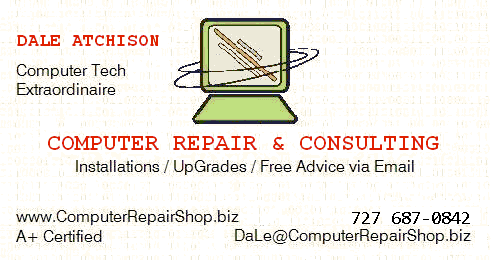 |
Hints Tips & Rants
by Dale Atchison Tampa Bay Computer Society |
For the past eight or nine years, I've inflicted my opinions regarding free software on anyone who would listen. I've tried to keep up with changes brought on by updates, upgrades (not always the same thing), takeovers, mergers, dissolutions, etc. The suite I recommend today in no way resembles the programs I pushed six years ago; they've all changed, but at a rate of less than one program a year.
Back in the day, I told all my clients, family, friends, and readers to use AVG for anti-virus, Spybot S&D and Ad-Aware for anti-spyware, ZoneAlarm for firewall, and ZipCentral to handle zipfiles. They all worked well, but for one reason or other, I no longer recommend any of them, except as detailed below.
AVG is still out there, it still does a good job, and it's still quite popular. But it's grown much larger, possibly to facilitate its slick new interface, and it no longer supports Win 98. Believe it or not, I still have clients running '98 and Millenium, and I recommend they continue to do so until there's something they want to do that requires a more advanced version. Since I didn't want to distribute and support two competing products, I needed to find a really good anti-virus that works on any version of Windows from '98 to Vista, is small for quicker download/installation time, has an easy-to-navigate interface, locks a computer down tight against all types of malware, but is still free for personal use: enter avast! 4.8. Like AVG, it's from the Czech Republic. Unlike AVG, it doesn't need to scan every day to see what got past it. At installation time, the program suggests you do a 'boot-time' scan; afterward, there will probably never be a need to scan again.
BTW, the 'boot-time' scan may be avast!'s most powerful weapon against malware: it's an opportunity to scan files that are already set up to run every time the computer boots, but before they load into memory. I've used avast! 4.8 to remove Win AntiVirus Pro 2008 and 2009 from several infected computers.
avast! 4.8 Free Edition: files.avast.com/iavs4pro/setupeng.exe
avast! 4.8 Pro: files.avast.com/iavs4pro/setupengpro.exe
Lavasoft's Ad-Aware was my favorite anti-spyware program for several years. But in 2007, they re-wrote the program, made it huge, and included a 'real-time' protection feature that 1. slowed my computer to a crawl, and 2. couldn't be turned off. Exit Ad-Aware. Besides, avast! includes anti-spyware, so why have two programs running that do the same thing?
Spybot Search & Destroy was (and is still) a great anti-spyware program, but its 'real-time' element, Tea-Timer, wasn't much. Early versions couldn't seem to format text and button layout properly, so I couldn't ever tell which button to click for Allow or Deny. And no matter how many times I clicked on Remember or Always or whatever they called their 'persist' button, it kept asking the same question over and over. The new version is better, but it came along too late: now that the major anti-virus programs all include real-time anti-spyware protection, you just don't need to waste resources running duplicate layers of protection. If you want to load Spybot S&D --- without Tea Timer --- go ahead; use it to scan your computer every now and then to see what a great job avast! is doing keeping spyware off your computer.
Spybot Search & Destroy: www.safer-networking.org/en/mirrors/index.html
The only 'real-time' protection I use, other than avast!, is WinPatrol. It watches for changes in your Windows startup environment. Anything that tries to set itself up to start automatically each time the computer boots, has to get past WinPatrol's cute little watchdog, Scottie. And the final decision is always yours; Scottie always waits for your okay before allowing a change to your Startup folder, the Run keys in the Registry, Autoexec.bat, Config.sys, Win.ini, Wininit.ini, System.ini, Internet home page, default Search engine, Hosts file, even file associations.
WinPatrol 2009: www.winpatrol.com/wpsetup.exe
Back when Win 98 was the newest and fastest Windows ever, ZoneAlarm was the firewall of choice. But like just about every other program ever, it grew, and grew, and then it grew some more. Meanwhile, Microsoft included a pretty good firewall free in XP Service Pack 1, then took an audacious giant step and actually turned it on by default in Service Pack 2. If you're still running Win 98, ME, or 2000, or if you just want outbound protection included (Windows' firewall only protects against inbound threats), I now recommend SafetyNet. It works on all versions of Windows from '95 to XP; sorry, not Vista, at least not yet.
SafetyNet Free Firewall: www.netveda.com/downloads/downloadform.asp?product=sn&lic=serv
Zipfiles: I didn't like Winzip. It was too large, it was shareware (I prefer freeware), and I didn't think it worked as well as ZipCentral. All versions of Windows since Millenium have included 'native' handling of zipfiles, so you no longer need a separate utility for compressed files and folders. If you want to create self-extracting archives, or if you still use Win 98, ZipCentral is still the way to go; otherwise, just use the zip-handling capability that's built into Windows.
ZipCentral: hemsidor.torget.se/users/z/zcentral/zcsetup.exe
Backups
I'm probably the world's worst when it comes to "Do as I say, not as I do." I rant and rave to all my clients about having a recent backup on hand in case of disaster, but I hate taking the time to do them myself. I like Acronis TruImage Home, as it makes backing up quick and relatively painless; but it's not free. (Did I mention I prefer freeware?)
Like Acronis, Macrium Reflect allows you to back up your entire hard drive to an external drive, including all the Windows files that are actually in use at the time of the backup. (For those who care, this is done using Windows' Shadow Copy capability --- that's pretty much all I know on the subject.) And a bootable CD you create from within Macrium Reflect will allow you to boot a computer that has lost it's boot hard drive, find the latest Reflect backup file on your external drive, and restore the disk image to your new blank disk.
An added bonus: if you enable the XML feature as you backup, you can browse the disk image from within Windows, just like it had already been restored to a new hard drive, and restore individual files and folders. How cool is that, especially for a free program?!
Till next month...





